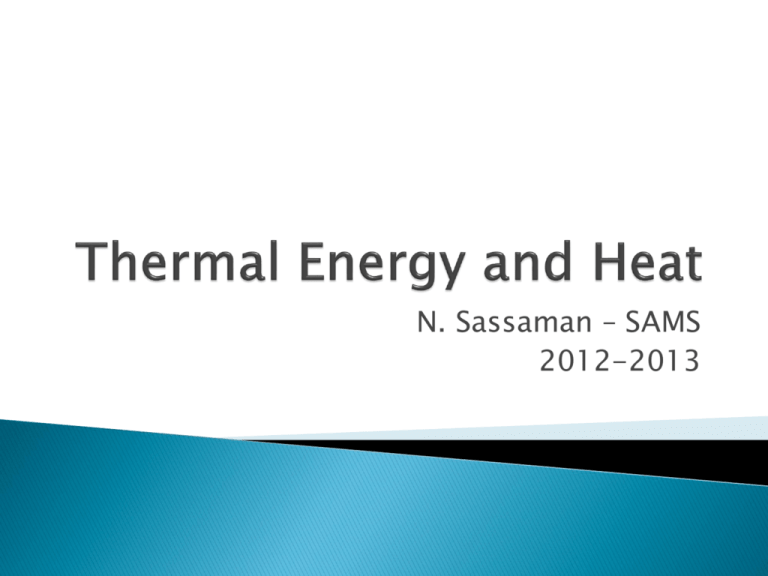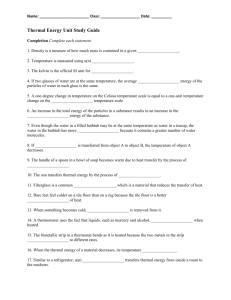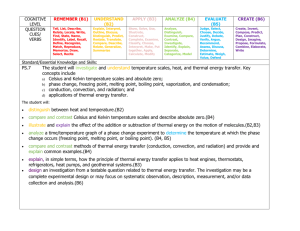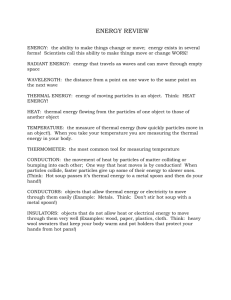Thermal Energy and Heat
advertisement

N. Sassaman – SAMS 2012-2013 Temperature, Thermal Energy and Heat Temperature is a measure of the average kinetic energy of the individual particles in matter. Temperature, Thermal Energy and Heat Temperature changes cause the level of the liquid inside a thermometer to rise and fall. Temperature, Thermal Energy and Heat The three common scales for measuring temperature are the Fahrenheit, Celsius, and Kelvin scales. The total energy of all the particles of a substance. Depends on: ◦ Temperature ◦ Number of particles (amount of substance) ◦ Substance itself For example: ◦ A large pot of boiling water has more thermal energy than a small cup of boiling water. Kinetic energy (motion) Temperature (average) Thermal energy (total) To convert a Fahrenheit temperature to a Celsius temperature, use the following formula: ºC = 5/9 (ºF – 32) For example, if the temperature in your classroom is 68ºF, what is the temperature in degrees Celsius? ºC = 5/9 (68 – 32) ºC = 5/9 X 36 ºC = 20 The temperature of your classroom is 20ºC. Practice Problem While at the beach, you measure the ocean temperature as 77ºF. What is the temperature of the ocean in degrees Celsius? 25ºC 1. 2. 3. 4. 5. 6. 7. 8. 9. No – thermal energy depends not only on temperature, but also the amount and type of material. A) Celsius B) 0 C) 0° D) 212° B E A F D C G - The Transfer of Heat If two objects have different temperatures, heat will flow from the warmer object to the colder one. Temperature, Thermal Energy and Heat http://www.neok12.com/php/watch.php?v=zX615658021a7c56507d7977&t=HeatTemperature http://www.neok12.com/php/watch.php?v=zX61086240457a69466a7677&t=HeatTemperature Energy Measured Temperature Thermal Energy Heat Average kinetic energy of particles Total energy of all particles in an object Usually used when discussing transfer Units Fahrenheit or Celsius degrees, Kelvins Joules Joules Temperature, Thermal Energy and Heat HIGH specific heat = heats up slowly LOW specific heat = heats up quickly The amount of energy required to raise the temperature of 1 kg of a substance by 1 Kelvin. A material with a high specific heat can absorb a great deal of thermal energy without a great change in temperature. Example: sand gets hotter faster than water (sand has lower specific heat than water) http://oceanservice.noaa.gov/education/pd/oceans_weather_climate/me dia/specific_heat.swf Specific heat of a substance = Change in Energy (heat/energy needed in J) Mass (kg) x Change in temp. (K) Change in energy (heat/energy needed) = Mass x Specific heat x Change in temp. (kg) J = Joules (J/(kg·K)) kg = kilograms (K) K = Kelvin - The Transfer of Heat http://www.teachersdomain.org/asset/lsps07_int_heattra nsfer/ http://www.nd.edu/~ysun/Yang/PhysicsAnimation/collect ion/transportP.swf Main Idea Heat can be transferred in three ways. Detail Detail Conduction– transfer of heat between particles without the movement of matter. Convection– transfer of heat by the movement of currents in a fluid. *direct contact of materials* *hot rises, cool sinks* Detail Radiation– transfer of energy by electromagnetic waves. *through ‘empty’ space* 1. 2. 3. 4. 5. 6. Conduction Radiation Conduction Conduction Convection Radiation 7. 8. 9. 10. 11. 12. Conduction Conductor Convection current Insulator Radiation Convection Conductor examples: Metals (silver, stainless steel); tile floor. Insulator examples: Wood, wool, straw, paper, cork, gases, rug, clothes, blankets, feathers, blubber, fiberglass. **low specific heat value** ** high specific heat value** Thermal Energy and States of Matter Most matter on Earth can exist in three states–solid, liquid, and gas. - The Properties of Water Ice is solid water, the familiar form of water is a liquid, and the water vapor in the air is a gas. http://www.media.pearson.com.au/schools/cw/au_sch_whalley_sf1_1/int/matter.html - States of Matter A fixed, closely packed arrangement of particles causes a solid to have a definite shape and volume. - States of Matter Because its particles are free to move, a liquid has no definite shape. However, it does have a definite volume. - States of Matter As they move, gas particles spread apart, filling all the space available. Thus, a gas has neither definite shape nor definite volume. - Changes of State The change in state from a solid to a liquid is called melting. - Changes of State The change of state from liquid to solid is called freezing. - The Properties of Water Water moves between the liquid and gaseous states by evaporation and condensation. Water moves between the liquid and solid states by freezing and melting. http://www.media.pearson.com.au/schools/cw/au_sch_whalley_sf1_1/int/2_slg.html http://www.footprints-science.co.uk/flash/states.swf Thermal Energy and States of Matter Matter can change from one state to another when thermal energy is absorbed or released. http://www.brainpop.com/science/matterandchemistry/matterchangingstates/ - Changes of State A beaker of ice at –10ºC was slowly heated to 110ºC. The changes in the temperature of the water over time were recorded. The data were plotted on the graph shown here. Reading Graphs: ◦ What two variables are plotted on the graph? ◦ Temperature (ºC) on the y-axis, time (minutes) on the x-axis Reading Graphs: ◦ What is happening to the temperature of the water during segment C of the graph? ◦ The temperature is rising from 0ºC to 100ºC. Interpreting Data: ◦ What does the temperature value for segment B represent? For segment D? ◦ Segment B: melting point of ice; segment D: boiling point of water Drawing Conclusions: ◦ What change of state is occurring during segment B of the graph? For segment D? ◦ Change from solid to liquid; change from liquid to gas Inferring: ◦ In which segment, A or E, do the water molecules have more thermal energy? Explain your reasoning. ◦ Water molecules in segment E have more thermal energy because they are at a higher temperature. Thermal Energy and States of Matter As the thermal energy of matter increases, its particles spread out and the substance expands. A bimetallic strip in a thermostat contracts or expands depending on whether it is cooled or warmed. Thermal Energy and States of Matter Using a word in a sentence helps you think about how best to explain the word. After you read the section, reread the paragraphs that contain definitions of Key Terms. Use the information you have learned to write a meaningful sentence for each Key Term. Key Terms: state evaporation change of state boiling melting condensation freezing thermal expansion Examples: If vaporization Water can existtakes in three place different at the surface states, or of a forms. it is called evaporation. liquid, The physical change from one state of matter to At higheristemperatures, vaporization another called a change of state. can occur below the surface of a liquid as well. This process The change of state from a solid to a liquid is is called boiling. called melting. A change from the gas state to the liquid state is called condensation. The change of state from a liquid to a solid is The expanding called freezing. of matter when it is heated is known as thermal expansion. 1. 2. 3. 4. An increase in thermal energy (increases movement of particles). All extra energy goes into breaking solid bonds instead of raising temperature. Thermal expansion! Ties would buckle/break in summer. Solid, liquid, gas 5. 6. 7. 8. 9. 10. 11. 12. Melting States Condensation Evaporation Boiling Freezing Thermal expansion Change of state







